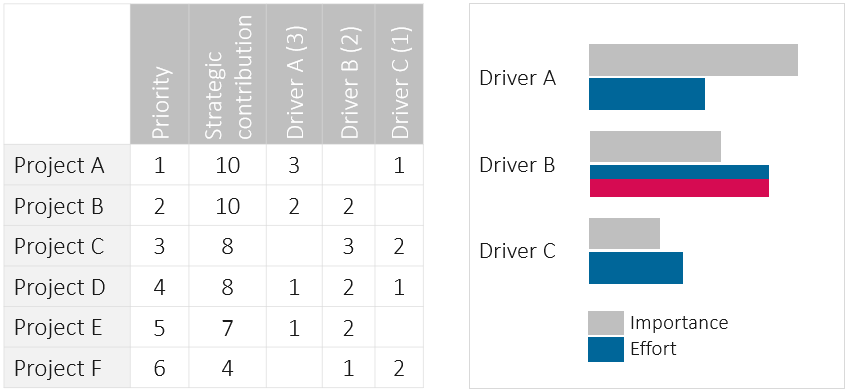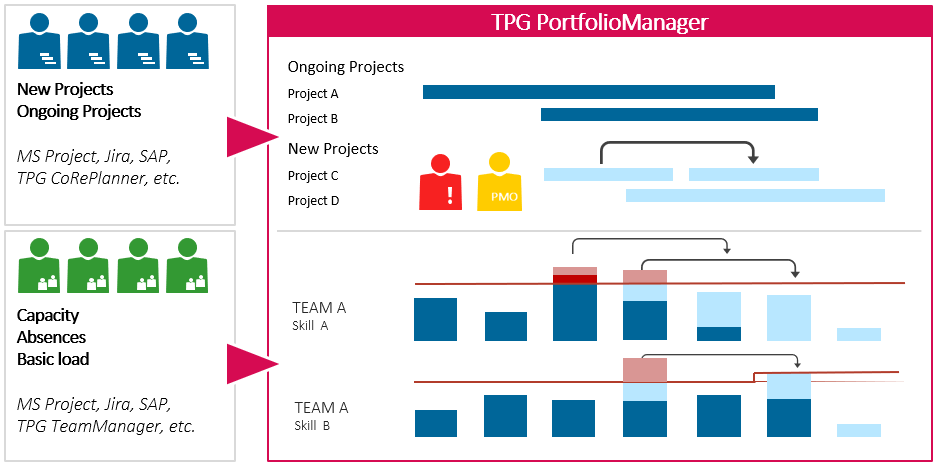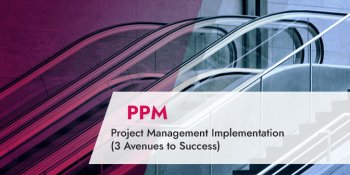In a multi-project environment, the particular challenge is this: resources such as budgets and employees tend to be required by several projects at once. What is more, projects are often interdependent or even mutually exclusive. Good project portfolio management will help you keep an overview and enable you to take control.
In this article, you will learn the fastest way to achieve functioning and accepted project portfolio management in your company using our 7-step guide. The below topics will be discussed:
- Project portfolio management definition
- Why implement project portfolio management? Important arguments
- The 7-step guide to optimizing your project portfolio management
- Step 1: Define criteria for projects
- Step 2: Define a process for project initiation
- Step 3: Define a method for prioritization
- Step 4: Start with a complete overview of running projects
- Step 5: Compare the planned new projects with the remaining capacity and budget
- Step 6: Keep a constant eye on project handling
- Step 7: Close projects with a regulated project closure process
- Conclusion: Project portfolio management 7-step guide
Let us start with the question: What is project portfolio management?
Project Portfolio Management Definition
Project portfolio management (PPM) ensures that you work on the right projects as a company, i.e., you have the optimal mix of projects to achieve the company’s goals. The project portfolio management process encompasses:
- Assessing the project pipeline
- Selecting projects based on their urgency / importance
- Allocating resources
- Monitoring the progress and goal achievement of all projects.
Portfolio management is a regular task that is usually supported by a PMO.
Why Implement Project Portfolio Management? Important Arguments
In a nutshell, the five most important reasons to implement project portfolio management are:
- Focusing on “feasible” and “economically viable” projects
- Having a complete overview of your portfolio
- Benefitting from a clear preparation for selecting the projects
- Making your decisions based on priorities in accordance with corporate strategy
- Planning your capacities ahead of time
Special Download: 7-Step Guide to Project Portfolio Management (PDF file)
Please fill in the form.
* Required Fields | Data Protection
Often, another question comes up:
What Is the Difference between Project Portfolio Management and Multi-Project Management?
In our view, project portfolio management addresses the strategic aspects of enterprise-wide project portfolio. The motto for this is: “Do the right projects.”
Multi-project management, on the other hand, encompasses only a subset of all enterprise-wide projects, e.g., those included in the project list of one organizational unit and not assigned to a program (cf. program management). The corresponding motto for each individual project is: “Do the projects right.”
There is no one universally applicable definition of both terms, however.
The 7-Step Guide to Optimizing Your Project Portfolio Management
To be able to assess a portfolio of projects, you must first have information on every individual project. Based on these factors, you subsequently rate your projects.
For each project, ask the following questions to begin with:
- What is the strategic relevance of the project?
- What is the cost?
- What are the resource requirements?
- What deadlines must be met?
The challenge of project portfolio management is to determine the optimal combination of your projects in the portfolio, usually using strategic criteria (business drivers). Thus, you decide:
- Which projects to implement next
- Which ones are less important and will have to wait
In the subsequent 7 steps, you will learn in detail how to implement the project portfolio management process to set up a successful portfolio environment.
Step 1: Define Criteria for Projects
Not all undertakings are projects. Much can be handled as part of operations. The project-worthiness analysis determines from what point an undertaking is to be treated as a project.
It can help to differentiate projects based on the project type (minor / normal / major project). This will allow you to define the methods to be used.
| Number of areas involved | 1 area | Up to 3 areas | Over 3 areas | Up to 3 areas |
| Size of entire project team | 2 – 5 people | Over 6 people | Over 12 people | Over 6 people |
| Resource requirements | 10 – 30 man-days | 30 – 100 man-days | Over 100 man-days | 30 – 100 man-days |
| Capital expenditure | Under 10.000 € | 10.000 – 50.000 € | Over 50.000 € | 10.000 – 50.000 € |
| Duration | 1 – 3 months | 4 – 10 months | Over 10 months | 4 – 10 months |
| Inherent complexity | Low | Medium | High | High |
| Novelty for project team | Low | Medium | High | Low |
| Quality risk | Low | Medium | High | Medium |
| External impact | Low | Medium | High | Low |
The project-worthiness analysis determines from what point an undertaking is to be treated as a project
With this approach, you can easily define from what point an undertaking is to be considered a project. Only then is it to be added to the project portfolio selection process.
Design your individual project-worthiness analysis according to your requirements. Possible criteria for this could be:
- Number of departments involved
- Size of the project team
- Staff costs
- Amount of investment
- Duration
- Inherent complexity
- Novelty for the project team
- Quality risk
- External effect
Our tip: Download the free Excel template for your project-worthiness analysis. You can easily adapt the template to your needs.
Special Download: 7-Step Guide to Project Portfolio Management (PDF file)
Please fill in the form.
* Required Fields | Data Protection
Step 2: Define a Process for Project Initiation
At any rate, you should ensure one thing when selecting the portfolio: incorporate all projects requested internally or externally. Therefore, define a uniform process for initiating projects.
It is best to use a central idea management software for the standardized recording of tasks, ideas, and project requests. Specify a methodical approach including:
- Workflows
- Permissions
- Criteria for the steps of approval
Reading tip: How to implement idea management – benefits and success factors.
And see to the appropriate quality of planning for new projects.
Find answers to the following questions in your project portfolio process:
- How are project requests or ideas collected?
- In what way are potential projects assessed?
- How does the approval process work? And who is involved in it?
- Which PPM tools should be employed?
- How do you ensure that all involved know about the process and actually live it?
- How do you guarantee the quality of the new projects’ rough planning?
Our tip: Make sure the project portfolio process you design is as simple as possible. This will ensure acceptance and is especially important if you are performing project portfolio management as PMO members. Additional change management will further increase acceptance.
Read article on the importance of Change Management in Project Management.
Special Download: 10 Vital PMO Success Factors (PDF file)
Please fill in the form.
* Required Fields | Data Protection
Step 3: Define a Method for Prioritization
Prioritization is not a one-off activity. Whenever the circumstances change, you have to adapt your priorities. You can determine the strategic relevance of the projects by assigning business drivers proportionally.
These drivers must be clearly separated and distinct in meaning. Possible drivers can be:
- Increasing product quality
- Achieving a higher customer satisfaction
- Increasing staff satisfaction
- Achieving higher cost efficiency
- Expanding into new markets
What is more, the drivers need to be complete from a strategic perspective. In this case, complete means that the drivers should be as few as possible but as many as necessary.
Subsequently, you define the drivers’ importance among themselves.
Our tip: Choose at least 3 strategic drivers but fewer than 10. This will ensure good handling and a meaningful overview on a sensible basis.
Step 4: Start with a Complete Overview of Running Projects
First, you record all running projects with their essential information. To do this, use a central, database-assisted list in your project management software, for instance Microsoft project portfolio management (PPM).
Special Download: Advantages of MS Project Server / Project Online over MS Project Standard
Please click here to download the PDF and learn why you should prefer the server over the client version.
The required project information should include at least:
- Start
- Finish
- Effort
- Cost
- Sponsor
- Project manager
Assign the relevant strategic business drivers to each of the existing projects.
Proceed by checking whether the most effort actually goes towards the most important projects. To this end, compare the importance of the drivers with the corresponding efforts of the assigned projects.

Identify unimportant projects it might be best to stop. This can liberate resources for more important new projects.
Our tip: It is hard to present the financial value of a project that does not produce direct revenue. So it is best to put the initial focus on the importance resulting from the strategic drivers. You can always add a financial evaluation later. You can also divide the project portfolio into projects with revenue and those without.
Step 5: Compare the Planned New Projects with the Remaining Capacity and Budget Available
In the next step, you add your list of desired additional projects to the portfolio of running projects. Appropriate portfolio management software provides optimal support for this task through transparent overviews of projects and resource utilization over the relevant period.
Compare the new projects’ effort and cost planning with the remaining capacity and budgets available. This is about finding out which project could start when.
It will be necessary to plan all new projects roughly. Thus, the resource requirements along the timeline become apparent. Planning should not be down to the level of persons but to skills. This will keep the effort lower.

Learn why to use skills management in this article.
Watch this related video: Ad-hoc Optimization of Resource Utilization in a Microsoft Project Portfolio (TPG PortfolioManager)
Of course, you will have to assign the new projects to the strategic drivers. Otherwise, it will be difficult to prioritize the new projects with the highest strategic contribution.
Only include small projects with low strategic contribution at the end, to fill in the gaps.
Our tip: Make your planning as rough as possible but as detailed as necessary. This step requires very little. The guiding principle is: better to make your planning complete and rough than to make it incomplete and too detailed. In other words, it is preferable to have ALL projects show up in the overview, at least roughly. Leaving some out altogether is not advisable. In that case, an overall statement about the feasibility becomes impossible. You are dealing with incomplete data.
Step 6: Keep a Constant Eye on Project Handling
The penultimate project portfolio management task is constant control. You should ensure at all cost that the data of all projects is:
- Regularly updated.
- Reported back to the central PPM solution.
The current data is the basis you need, if you ever want to determine:
- Whether new projects can be started in the future.
- When these projects could be started.
- What kind of projects they could be.
You should monitor the portfolio continuously. Also, keep checking the priorities of running projects.
Whenever strategic guidelines change, there is one thing you should not rule out. Consider aborting projects if they are not in line with the new strategic direction.
Our tip: Arrange for a monthly project portfolio meeting. The latter has to be prepared well by the PMO. The following goes for projects that need to be stopped: rather a calamitous end than an endless calamity.
Step 7: Close Projects with a Regulated Project Closure Process
You should have every project undergo a closure process. The latter includes a final project review with a target-actual comparison of costs and results.
In addition, you should:
- Communicate the Lessons Learned
- Archive the project properly
- Discharge the responsible project manager officially (relieve him or her of the responsibility for the finished project)
After that, everyone is aware that a project has been declared closed. And that the staff can now be assigned to other projects.
Our tip: In the interest of good company culture and communication, consider this: successfully completed projects could be a reason to celebrate. Alongside the results and successes, you would be able to present Lessons Learned. The occasion would give you an opportunity to increase the responsible project managers’ motivation for future projects.
Conclusion: Project Portfolio Management 7-Step Guide
This article has taught you that project portfolio management is a key task in achieving corporate strategic objectives. In most cases, regular portfolio meetings are prepared by a project management office (PMO). Depending on the nature of the PMO, the responsibility for the portfolio can go even further.
Specifically, however, the steps with which you can set up sound project portfolio management in a target-oriented manner are:
- Define criteria for projects
- Define a process for project initiation
- Define a method for prioritization
- Start with a complete overview of running projects
- Compare the planned new projects with the remaining capacity and budget
- Keep a constant eye on project handling
- Use a closure process for projects
These practical tips will allow you to determine the optimal portfolio of projects accurately. Those projects should either
- serve the implementation of your strategy in the long run or
- bring improvements in the short run.
Our final tips
Get to know the individually adaptable “PPM Paradise” – the optimal environment for your enterprise-wide project, program, portfolio and resource management. Download the eBook now (just click, no form).
And sign up for our bi-weekly blog newsletter to make sure you receive all our updates.
Is there anything you feel we have missed? What has been your experience with project portfolio management? We look forward to receiving your comments.
 Achim Schmidt-Sibeth (Senior Marketing Manager)
Achim Schmidt-Sibeth (Senior Marketing Manager)
After earning his engineering degree in environmental technology, he gained many years of experience in project management through his work at an engineering office, an equipment manufacturer, and a multimedia agency. Achim Schmidt-Sibeth and his team have been responsible for marketing and communication at TPG The Project Group for many years now.
Read more about Achim Schmidt-Sibeth on LinkedIn or XING
 Johann Strasser
Johann Strasser
(Managing Partner at TPG)
The certified engineer, has been a managing partner at TPG The Project Group since 2001. After many years as a development engineer in the automotive and energy sectors, Johann Strasser spent a decade as an independent trainer and consultant in the field of project management. During his tenure, he also served as project manager for software projects in the construction industry and provided scheduling and cost management support for large-scale construction projects. At TPG, he applies his expertise in product development and consulting services for international clients. His special focus is on PMO, project portfolios, hybrid project management, and resource management. For many years now, he has shared his knowledge through presentations, seminars, articles, and webinars.







2 Comments
in your table for defining criteria for projects…when you discuss “resource requirements and give the examples of “10-30 m-days”…what type of resources are you referring to? and what does 10-30 m-days mean?
thank you!
Susie, thank you so much for your comment. The acronym “m-day” for “man-day” may not be too common, so I have changed it to “man-day” in the table (Figure 1). “Resource requirements” refers to human resources, i.e. employees required to staff the project. These requirements are calculated in “man-days”. More on the concept of the “man-day”: https://en.wikipedia.org/wiki/Man-hour#Similar_units
I hope this has answered your question.